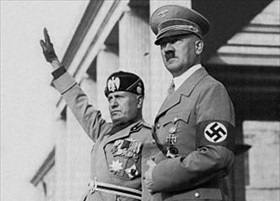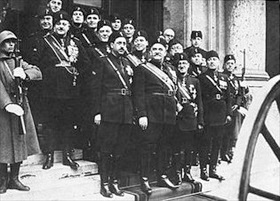ITALIANS PUBLISH ANTI-SEMITIC MANIFESTO
Rome, Italy · November 17, 1938
On July 14, 1938, Italy’s Manifesto of Racial Scientists (Manifesto Degli Scienziati Razzisti) laid out a scientific explanation for the politics of biological racism. Signed by 42 eminent Italians, the manifesto, published in Il Giornale d’Italia, a newspaper strongly supporting Benito Mussolini’s Fascist regime, declared that Italians belonged to the Nordic race and were completely “Aryan,” while Jews, being “Semitic,” “do not belong to the Italian race” and “represent the only population which has never assimilated in Italy.” “It is time,” the Manifesto of Race insisted, “that the Italians proclaim themselves frankly racist.” The manifesto, exposed days later by the Italian newspaper Il Popolo d’Italia to have been written in the Ministry of Popular Culture on Mussolini’s instructions, was thus prelude to Italian racist laws, or Laws for the Defense of the Race (Provvedimenti per la difesa della razza italiana), published on this date in 1938.
Owing something to the Nazis’ anti-Semitic laws of 1933–1935, as well as to Adolf Hitler’s never losing an opportunity to lecture Mussolini on the subject of race, the Laws for the Defense of the Race reversed more than a century of social and economic integration by Italy’s tiny and highly assimilated Jewish minority. Among others things the new laws decreed that marriages between Aryans and non-Aryans were henceforth illegal, banned Jews from employing domestic servants “of the Aryan race,” banned Jews from performing military service in peacetime or war, and barred Jews from owning or managing any business with more than one hundred employees or which received defense contracts. Additional regulations sought the complete segregation of Jews from society and the professions; e.g., Jews could no longer work for banks or insurance companies.
An incensed Pope Pius XI sent a letter to Mussolini protesting the new laws, which had been championed not by the “scientific community” (that was Mussolini’s cover story) but almost solely by tactical considerations on the part of the ardent pro-German wing of the National Fascist Party (PNF) and by Mussolini himself, who stressed the impossibility of close national allies (meaning Italy and Germany) having a diversity of attitude. The effect of Italian race laws was the “Aryanization” of businesses, jobs, and education; large-scale Jewish emigration; forced labor and ghettoization; and the active collaboration of Italians in killing over 6,000 Italian Jews (or about 15 percent of Jewish Italians) and terrorizing countless more during the Holocaust.
Mussolini, Hitler, and the Italian Fascists’ Anti-Semitic Campaign
 |  |
Left: Mussolini and Hitler review Nazi Party troops parading before one of two “Honor Temples” (Ehrentempel) on Koenigsplatz in Munich, September 25, 1937. Early in May 1938 Hitler paid a visit to the Italian capital. The most tragic effect of the German leader’s visit was the start of the Italian racist and anti-Semitic campaign. Because he could not abide his closest ally not embracing his racist ideology, Hitler sent a Nazi delegation of race “experts” to visit the extremist wing of the National Fascist Party just one month after his visit.
![]()
Right: Supervising the Italian anti-Semite campaign was the anticlerical, xenophobic Fascist politician, lawyer, and journalist Roberto Farinacci (1892–1945), seen here on January 1, 1935, in the front row (extreme right) during a New Year’s function of the party faithful. A member of the Grand Council of Fascism (1935–1943), Farinacci was a signatory to “Il Manifesto della Razza,” a piece that appeared in the magazine Difesa della Razza in its August 5, 1938, issue. Mussolini selected him to introduce the unpopular Fascist race laws of 1938. Sharing Mussolini’s fate, Farinacci was captured by Italian partisans, summarily tried, and executed in Vimercate’s (Northern Italy) municipal square in late April 1945.
History’s Verdict: Benito Mussolini. Mussolini’s Anti-Semitism Described at 30 Minutes into Video
![]()

 History buffs, there is good news! The Daily Chronicles of World War II is now available as an ebook for $4.99 on Amazon.com. Containing a year’s worth of dated entries from this website, the ebook brings the story of this tumultuous era to life in a compelling, authoritative, and succinct manner. Featuring inventive navigation aids, the ebook enables readers to instantly move forward or backward by month and date to different dated entries. Simple and elegant! Click
History buffs, there is good news! The Daily Chronicles of World War II is now available as an ebook for $4.99 on Amazon.com. Containing a year’s worth of dated entries from this website, the ebook brings the story of this tumultuous era to life in a compelling, authoritative, and succinct manner. Featuring inventive navigation aids, the ebook enables readers to instantly move forward or backward by month and date to different dated entries. Simple and elegant! Click 











